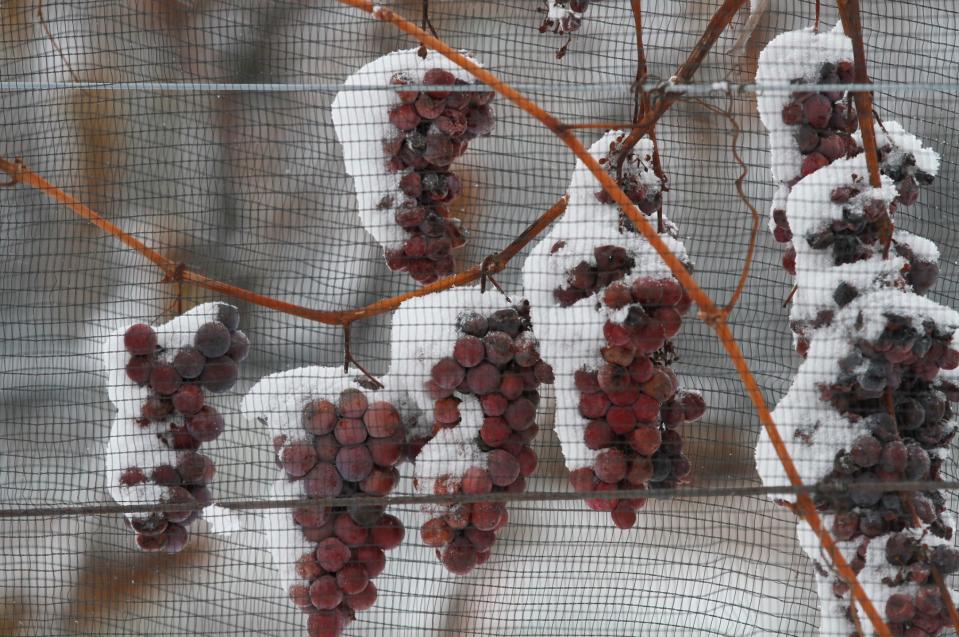Ice wine, maple syrup and more: How warmer winters affect New York specialties
I made the snowy drive down to Cayuga Lake on Friday to speak with the winemakers at Sheldrake Point Winery in Ovid as part of a story coming soon on ice wine production in the Finger Lakes.
The conditions required to create the sweet liquid treat, truly a dessert unto itself, are cold temperatures and a hardy enough grape harvest to last until those temperature goals — between 12 to 18 degrees — are met.
The first opportunity for Finger Lakes wineries came on Jan. 17, amid the cold snap gripping the state following the second-warmest Rochester December on record.
Finger Lakes ice wine: The cold is in the name
When ice wine can be harvested really comes down to those conditions — and there’s no set timeline for when that occurs. As Sheldrake Point winemaker Dave Breeden told me, the ice wine harvest often happens in January, but it can occasionally be December or as late as February and March — and sometimes not at all.
The three preeminent regions for ice wine, where climate for grape growing and cold winter temperatures frequently align, are the Finger Lakes, Germany and Canada, especially British Columbia and Ontario. The generally agreed-upon origin story for ice wine, or eiswein, traces back to late 18th-century Germany.

Despite being the likely origin of the dessert treat, ice wine harvests in Germany were largely a well-documented bust in 2020. International headlines decried the impact of climate change on the specialty wine, as the winter of 2019-20 failed to produce the frigid temperatures required to freeze the grapes. It was, and remains, the warmest winter on record for Europe.
One vineyard, Weingut Zimmerle, was able to produce the country’s only 100 liters of ice wine in 2020.
This year, however, there has been an ice wine harvest in Germany, highlighted by a cold spell in the first week of January. One winery was able to produce 400 liters of eiswein during the cold snap alone, according to the German Wine Institute.
New York winters are warming
Winters aren’t just warming in Europe, as data shows a significant warming trend in the United States as well. Rochester has seen the average temperature of its winters warm by 4.5 degrees since 1970, according to data from Climate Central, a nonprofit group of scientists and communicators.
The state Department of Conservation has outlined some impacts of warmer winters, including more lake effect snow in the coming decades due to less ice cover on the Great Lakes and impacts to outdoor recreation activities. Warmer winters also mean earlier springs, which can extend growing seasons, but also impacts what crops can be grown and demand for irrigation.
It also impacts the timing of tapping for maple trees to produce sap for maple syrup, which requires freezing temperatures at night and a daytime thaw. A 2019 study from Dartmouth College found the timing of sap collection will shift earlier in the year and last fewer days as a result of warming temperatures.
While it’s easy to forget our mild start to this winter amid a cold snap, mild temperatures are expected to return. Whatever the temperature, though, ice wine makes for a delightful, sweet treat, either on its own or paired with a strongly-flavored cheese like blue cheese.
More: Bitter cold grips Rochester. How long will it last?
More: So long to 25 Rochester restaurants, bars and breweries we said goodbye to in 2023
— Steve Howe covers weather, climate and lake issues for the Democrat and Chronicle and enjoys a good wine slushie in the summer. Have any insight into changing weather or climate? Share with him at showe@gannett.com.
This article originally appeared on Rochester Democrat and Chronicle: When can you get ice wine in New York? The season for eiswein.

